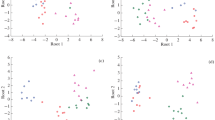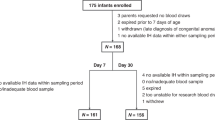Abstract
Serotonin (5HT) is a potent vasoconstrictor of the pulmonary vascular bed and may be involved in the pathophysiology of secondary pulmonary hypertension in children with a left-to-right shunt due to a congenital heart defect. To test this hypothesis we measured the total and free 5HT concentration in blood as well as the urinary excretion of its main metabolite 5-hydroxyin-doleacetic acid (HIAA) in children showing a left-to-right shunt with (n=10) and without (n=18) pulmonary hypertension. 5HT and HIAA were also measured in children after corrective cardiac surgery using cardiopulmonary bypass (n=14) and in controls without congenital heart disease (n=18). The concentrations of total and free 5HT were not significantly different between controls and patients with a left-to-right shunt. After cardiac surgery total 5HT concentration was significantly reduced by about 65% owing to a postoperatively reduced platelet count. In patients with a left-to-right shunt the total 5HT content was similar in the right atrium (204.0±17.3 ng/ml), pulmonary artery (189.0±19.1 ng/ml), and aorta (195.0±19.3 ng/ml), as was the free 5HT concentration. Therefore no net release of 5HT from platelets occurred between these sampling sites. In patients with pulmonary hypertension, the urinary excretion of HIAA was significantly increased when compared with controls and patients without pulmonary hypertension. It is concluded that turbulent blood flow in children with a left-to-right shunt does not lead to a significant release of 5HT from platelets. However, the increased urinary excretion of HIAA in patients with pulmonary hypertension indicates an increased turnover of 5HT, probably due to an increased number of intrapulmonary neuroepithelial cells or a higher metabolic rate of 5HT within those cells.
Similar content being viewed by others
References
Artigas F, Sarrias MJ, Martinez E, Gelpi E (1985) Serotonin in body fluids: characterization of human plasmatic and cerebrospinal fluid pools by means of a new HPLC method.Life Sci 37:441–447
Beer JH (1992) Plättchenrezeptoren: Nomenklatur-Struktur-Funktion.Schweiz Med Wochenschr 122:1249–1263 (part I), 1287–1304 (part II)
Ben-Harari R, Ermini P, Kleinerman J (1990) Metabolism of 5-hydroxytryptophan in the isolated perfused rat lung.Pharmacology 41:272–279
Van den Berg EK, Schmitz JM, Benedict CR, et al (1989) Transcardiac serotonin concentration is increased in selected patients with limiting angina and complex coronary lesion morphology.Circulation 79:116–124
Van den Berg EK, Schmitz JM, Benedict CR, et al (1987) Plasma serotonin concentrations: validation of a sampling technique using long catheters.Am J Med Sci 294:324–327
Breuer J, Meschig R, Breuer HWM, Arnold G (1985) Effects of serotonin on the cardiopulmonary circulatory system with and without 5-HT2-receptor blockade by ketanserin.J Cardiovasc Pharmacol 7(Suppl 7):S64–66
Celermajer DS, Cullen S, Deanfield JE (1993) Impairment of endothelium-dependent pulmonary artery relaxation in children with congenital heart disease and abnormal pulmonary hemodynamics.Circulation 87:440–446
Dargent F, Neidhardt P, Bachmann M, Suter PM, Junod AF (1985) Simultaneous measurement of serotonin and propranolol pulmonary extraction in patients after extracorporeal circulation and surgery.Am Rev Respir Dis 131:242–245
Gillis CN, Cronau LH, Greene NM, Hammond GL (1974) Removal of 5-hydroxytryptamine and norepinephrine from the pulmonary vascular space of man: influence of cardiopulmonary bypass and pulmonary arterial pressure on these processes.Surgery 76:608–616
Goldsmith BM, Feinstein C, Munson S, Reiss A, Borengasser-Caruso MA (1986) Determination of a reference range for whole blood serotonin in a pediatric population using high pressure liquid chromatography with electrochemical detection.Clin Biochem 19: 359–363
Hart CM, Block ER (1989) Lung serotonin metabolism.Clin Chest Med 10:59–69
Herve P, Drouet L, Dosquet C, et al (1990) Primary pulmonary hypertension in a patient with a familial platelet storage pool disease: role of serotonin.Am J Med 89:117–120
Ho HH, Lockitch G, Eaves L, Jacobson B (1986) Blood serotonin concentrations and fenfluramine therapy in autistic children.J Pediatr 108:465–469
Johnson DE, Lock JE, Elde RP, Thompson TR (1982) Pulmonary neuroendocrine cells in hyaline membrane disease and bronchopulmonary dysplasia.Pediatr Res 16:446–454
Lauweryns JM, Cokelaere M, Lerut T, Theunynck P (1978) Cross-circulation studies on the influence of hypoxia and hypoxaemia on neuro-epithelial bodies in young rabbits.Cell Tissue Res 193:373–386
Lauweryns JM, Cokelaere M, Theunynck P (1973) Serotonin producing neuro-epithelial bodies in rabbit respiratory mucosa.Science 180:410–413
Mankad PS, Chester AH, Yacoub MH (1991) 5-Hydroxytryptamine mediates endothelium dependent coronary vasodilation in the isolated rat heart by the release of nitric oxide.Cardiovasc Res 25:244–248
Meschig R, Breuer J, Breuer HWM, Arnold G (1985) Serotonin-induced vasoconstriction in the perfused canine femoral artery can be blocked in vivo by ketanserin.J Cardiovasc Pharmacol 7(Suppl 7) S56–59
Nakatami Y (1991) Pulmonary endocrine cells in infancy and childhood.Pedriatr Pathol 11:31–48
Ortiz J, Artigas F, Gelpi E (1988) Serotonergic status in human blood.Life Sci 43:983–990
Shihabi ZK, Scaro J (1980) Liquid-chromatographic assay of urinary 5-hydroxy-3-indoleacetic acid, with electrochemical detection.Clin Chem 26:907–909
Somerville B, Hinterberger H (1975) Levels of serotonin bound to platelets and free in plasma in jugular and forearm venous blood as determined by a fluorescent-opt assay.Clin Chim Acta 65:399–402
Tyce GM (1985) Biochemistry of serotonin. In: Vanhoutte PM (ed)Serotonin and the Cardiovascular System. Raven Press, New York, pp 1–14
Vanhoutte PM (1993) Endotheliale Dysfunktion und koronare Herzkrankheit.Schweiz Rundschau Med 82:1161–1166
Verstraete M (1985) Platelet activation in patients with atherosclerosis of the arteries of the limb. In: Vanhoutte PM (ed)Serotonin and the Cardiovascular System. Raven Press, New York, p 171
Author information
Authors and Affiliations
Rights and permissions
About this article
Cite this article
Breuer, J., Georgaraki, A., Sieverding, L. et al. Increased turnover of serotonin in children with pulmonary hypertension secondary to congenital heart disease. Pediatr Cardiol 17, 214–219 (1996). https://doi.org/10.1007/BF02524796
Issue Date:
DOI: https://doi.org/10.1007/BF02524796




